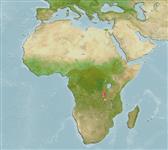Classification / Names
Common names from other countries
Main reference
Size / Weight / Age
Max length : 17.0 cm SL male/unsexed; (Ref. 4967); common length : 10.0 cm SL male/unsexed; (Ref. 4967)
Length at first maturity
Lm 6.8 range ? - ? cm
Environment
Freshwater; pelagic; non-migratory; depth range 20 - 40 m (Ref. 27631)
Climate / Range
Tropical; 21°C - 29°C (Ref. 5392), preferred ?; 3°S - 18°S
Distribution
Short description
Dorsal
spines
(total): 0;
Dorsal
soft rays
(total): 13-18;
Anal
spines: 0;
Anal
soft rays: 15 - 19;
Vertebrae: 41 - 44. Body fairly slender. Pre-pelvic scutes not strongly keeled, beginning behind base of last pectoral fin ray. Maxilla blade over 4 times as long as its shaft, its lower toothed edge continued forward to meet hind tip of pre-maxilla; second supra-maxilla asymmetrical, lower half larger. Lower gill rakers long and slender. A distinct silver stripe along flank. Snout broad with tapering sides, not concave when viewed from above. It has a large air bladder which is responsible for its ability to move great vertical distances.
IUCN Red List Status (Ref. 115185)
Threat to humans
Potential pest (Ref. 13055)
Human uses
Fisheries: commercial; bait: usually
Tools
Special reports
Download XML
Internet sources
Estimates of some properties based on models
Phylogenetic diversity index
PD50 = 1.0000 many relatives (e.g. carps) 0.5 - 2.0 few relatives (e.g. lungfishes)
Trophic Level
1.6 ±0.0 se; Based on diet studies.
Resilience
High, minimum population doubling time less than 15 months (K=0.86-1.2)
Vulnerability
Low vulnerability (10 of 100)
Price category
